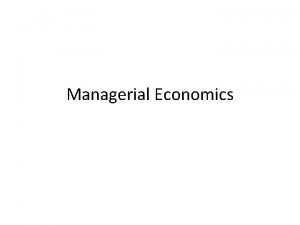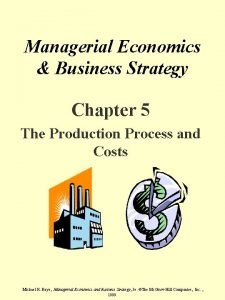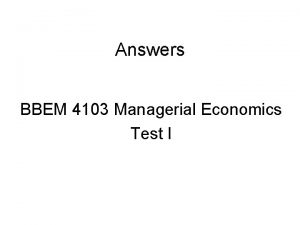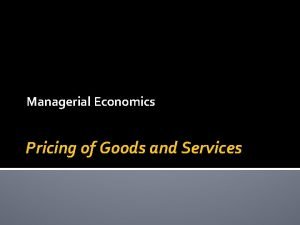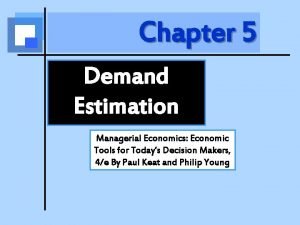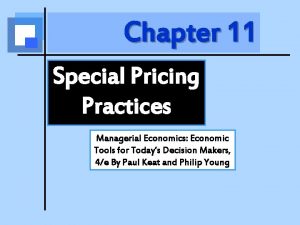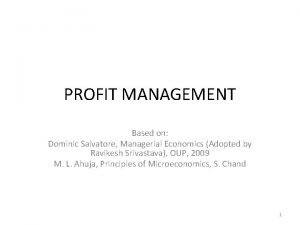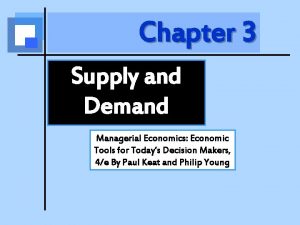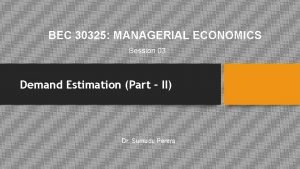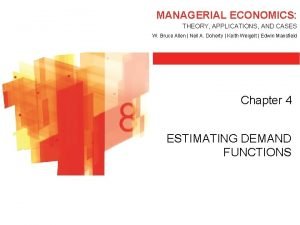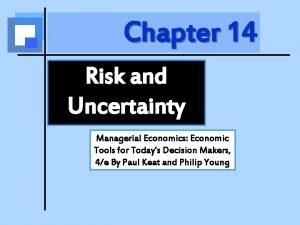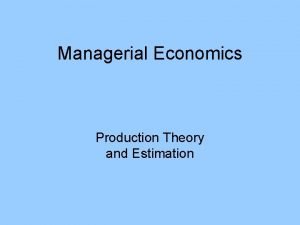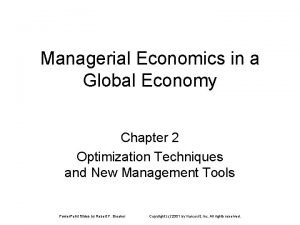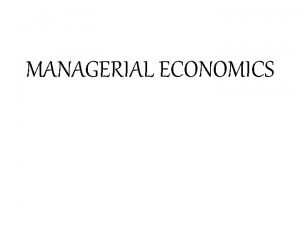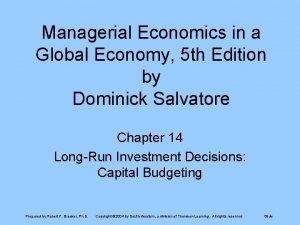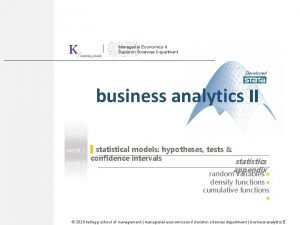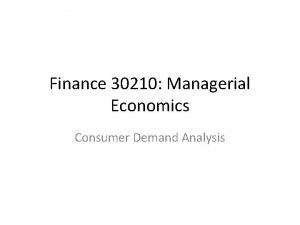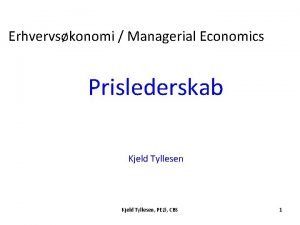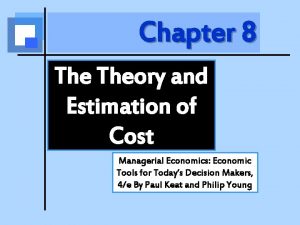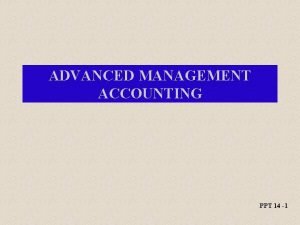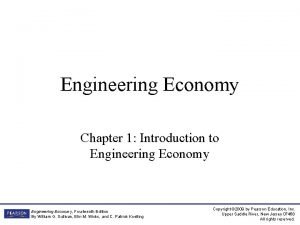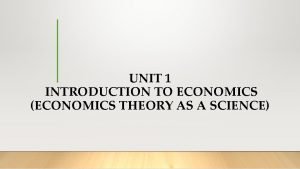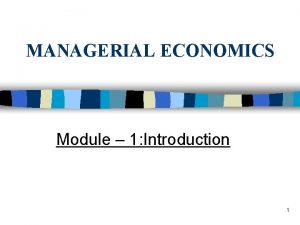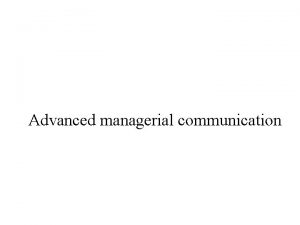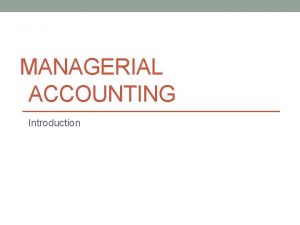INTRODUCTION TO MANAGERIAL ECONOMICS What is Economics It
























































- Slides: 56

INTRODUCTION TO MANAGERIAL ECONOMICS

What is Economics ? • It is a science of earning and spending wealth as defined by the Father of Economics Adam Smith in his classic work ‘An enquiry into nature and causes of the Wealth of Nations. ’ • In the opinion of Alfred Marshall it was study of mankind in ordinary business of life. • Lionel Robbins gave us the most accepted scarcity-oriented definition of Economics. He says Economics is a social science which studies human behavior as a relationship between unlimited wants and scarce means which have alternative uses.

INTRODUCTION OF MANAGERIAL ECONOMICS Concept of Managerial Economics (contd. ) Following diagram shows how does the managerial economics provide the link between traditional economics and decision sciences Management Problems Economic Theory Decision Sciences Managerial Economics Economic Methodology: Descriptive Model Prescriptive Model Study of Functional Areas: Accounting, Finance, and Marketing Optimal Decision 3

Definition of Managerial Economics • According to Mansfield , managerial economics is applied microeconomics. • Whether profit or non-profit making organisations and whatever may be their goals , they have all to face constraints which may be internal & /or external. • THE BASIC DECISION-MAKING PROCESS IS SAME FOR ALL FIRMS. • All managerial decision problems are solved with the help of tools , concepts and principles in…. a) Economic theory; b) Managerial economics c) Mathematical economics. • Role of economic theory---In any business, the businessman has to decide what , how , when , how much , whom , where etc.

. • The manager has to study environment at Micro as well as Macro levels. • Micro economics here the subject-matter is individual consumer , firm market , industry etc. Theories under micro-economics are : Theory of value, theory of distribution, theory of economic welfare etc. • Macro-economic environment is general eco-polsocial condition of the larger system which may be at domestic & /or international level.

Role of mathematical economics and econometrics--- • Mathematical economics is used to formalize economic laws. Eg. Law of demand can be expressed mathematically as Q =25 -3 (p) here demand is dependent variable and price independent variable ; moreover demand is inversely related to price. • Econometrics is application of statistics to real world. Empirically collected data can be applied to equations to find solution. eg. • Q= f (Y, Px , Py , W , U , T , E ----- ) • Trends revealed by forecasting help a firm take optimal decisions.

Scope of Managerial Economics Managerial economics can be used to explain and understand almost all business problems. Though it has late origin, due to applicability nature this subject is turned to be an area continuous research and innovation. Thus there is no unanimous way of explaining scope of managerial economics. The most common way is explaining its areas of study, which covers all those economic concepts, theories and tools of analysis which can be used to analyze issues related to demand projection, production and cost, market structure, level of competition and general environment. Mostly, these topics are rooted in economic theory (i. e. , micro- and macro economics). 7

Scope of Managerial Economics (contd. ) Microeconomics Applied to Operational Issues: Operational issues of firms are of internal nature. Internal issues include all those problems which arise within the business organization and fall within the control of the management. Some of the basic internal issues are: a) Choice of business and the nature of products, that is, what to produce, b) Choice of size of the firm, that is, how much to produce, c) Choice of technology, that is, choosing the factor-combination (technique of production) d) Choice of price, that is, how to price the commodity, e) How to promote sales, f) How to face competition, g) How to decide on new investments, h) How to manage profit and capital, i) How to manage an inventory, that is, stock of both finished goods and raw materials. 8

Scope of Managerial Economics (contd. ) Microeconomics Applied to Operational Issues: Microeconomics deals with such questions confronted by managers. The following microeconomic theories deal with most of these questions. a) Demand Analysis and Forecasting: - An understanding of the forces behind demand is a powerful tool for managers. Such knowledge provides the background needed to make pricing decisions, forecast sales and formulate marketing strategies. A forecast of future sales is essential before employing resources. b) Theory of Production and Production Decisions: - Production theory explains the relationship between inputs and output. It also explains under what conditions costs increase or decrease; how total output behaves when use of inputs is changed; and how can output be maximized from a given quantity of resources. Thus, it helps the managers in determining the size of the firm, and the amount of capital and labour to be employed keeping in view the objectives of the firm. 9

Scope of Managerial Economics (contd. ) Microeconomics Applied to Operational Issues: c) Market Structure and Pricing Theory: - Price theory explains how prices of outputs and inputs are determined under different market conditions; when price discrimination is desirable, feasible and profitable; and to what extent advertising can be helpful in expanding sales in a competitive market. Hence, price theory can be helpful in determining the price policy of the firm. d) Analysis of Cost: - Estimates of cost are essential for planning purposes. The factors determining costs are not always known or controllable which gives rise to cost uncertainty. Factors of production are scarce and they have alternative uses. Factors of production may be allocated in a particular way to get maximum output. Thus the analysis of costs and their links to output are also importance in managerial economics. 10

Scope of Managerial Economics (contd. ) Microeconomics Applied to Operational Issues: e) Profit and Capital Management (Investment Decisions): - Profit provides the index of success of a business firm. Profit analysis is difficult, because the uncertainty of expectations makes realization of profit planning and measurement difficult and these areas are covered in the study of managerial economics. Capital management means planning and control of capital expenditures. Hence, it is very important for a firm to manage required capital through proper investment planning. The main topics covered are: cost of capital, types of investment decisions, and evaluation and selections of investment projects. 11

Scope of Managerial Economics (contd. ) Microeconomics Applied to Operational Issues: f) Inventory Management: - Inventory refers to a stock of raw materials or finished goods which a firm keeps. Management of inventory is very important for a firm to keep intact of its current production and supply capacity and to meet the challenges arising from change in market and other conditions. In this regard, a major question that arises is: how much of the inventory is the ideal stock? If it is high, capital is unproductively tied up, and that might be useful for other productive purposes if the stock of inventory is reduced. On the other hand, if the level of inventory is low, production will be hampered. Hence, managerial economics uses different methods which are helpful in minimizing the inventory cost. 12

Scope of Managerial Economics (contd. ) Macroeconomics Applied to Business Environment: Macroeconomic issues relate to the general business environment in which a business operates. The factors which constitute economic environment of a country include the following. a. Types of economic system in the country; b. General trends in national income, employment, prices, saving and investment, etc; c. Trend in labour supply and strength of the capital market; d. Government’s economic policies: industrial policy, fiscal policy, monetary policy, price and foreign trade policies; e. Social factors like value system of the society, property rights, customs and habits; f. Socio-economic organization like trade unions, consumers’ associations, and producers’ unions g. The degree of globalization of the economy and the influence on the domestic markets. 13

Law of Demand • States that a quantity of a good demanded during a given period relates inversely to its price, other things constant. • Price increases Quantity Demanded decreases • Price decreases Quantity demanded increases • Creates a downward sloping demand curve

Why? • Substitution Effect • Unlimited wants/scarce resources • When the price of a good falls, consumers substitute that good for other goods, which become relatively more expensive. • Reverse also holds true

Why? • Income Effect • Money income: is simply the number of dollars received period • Real income: your income measured in terms of what it can buy. • A fall in the price of a good increases consumers’ real income making consumers more able to purchase goods; for a normal good, the quantity demanded increases.

Demand Curve A curve showing the relation between the price of a good and the quantity demanded. Price $6 Point on the line that matches the schedule $5 $4 $3 0 50 75 100 150 Every point on the line matches the schedule. It is a price/quantity demanded that consumers Demand are willing and able to buy. Quantity 200

Movement Along the Demand Curve • Caused by a change in price • Only a change in price • Move from one point to another on the same graph • Change in quantity demanded.

Movement along the Demand Curve Price B $6 A $5 Demand 0 75 100 Quantity

Demand • Individual demand • The demand of an individual consumer • Market demand • Sum of individual demands of all consumers in the market

Determinants of Demand • Changes in consumer income • Changes in prices of related goods • Changes in consumer expectations • Changes in the number or composition of consumers • Changes in consumer tastes

Changes in determinants • Results in changes to the RELATIONSHIP BETWEEN PRICE AND QUANTITY DEMANDED. • At each and every price a DIFFERENT quantity is demanded. • Results in a shift in the demand curve • New curve must be drawn

Changes in Demand • Increase in demand • At each and every price MORE of the good is demanded • Shifts to the right P Qd 1 Qd 2 $4 150 Price $5 A B D 2 200 $5 100 150 $6 75 100 D 1 100 150 Quantity

Causes of Increase in Demand • Increase in consumer income • Causes consumers to buy more of the product at each and every price. • Normal goods • Inferior goods

Change in consumer income • Normal goods • A good for which demand increases as consumer income rise • Inferior goods • A good which demand increases as consumer income falls

Changes in Price of Related Goods • Substitutes • Goods that are not consumed jointly • Goods that are related in such a way that an increase in the price of one shifts the demand curve for the other rightward. • Increase in price of Coke leads to increase in demand for Pepsi

Changes in Price of Related Goods • Substitutes • Suppose that the price of Coke rises from $1 to $1. 50, then the demand for Pepsi will decrease from 75 to 100. $1 D 2 D 1 75 100

Changes in the price of related goods • Complements • Goods that are related in a such a way that an increase in the price of one shifts the demand of the other leftward • Two goods that are consumed jointly. • An decrease in the price of one will increase demand for the other

Changes in Price of Related Goods • Complements • An decrease in the price of DVD players, increases the demand for DVDs • Suppose that DVD players decrease in price from $145 to $100, now the demand for DVDs will decrease from 750 at $20 to 900. $20 D 2 D 750 900

Changes in Consumer Expectations • Such as expectations in • Prices and income • Affect how consumers spend their money and their demand • If product cheaper today than tomorrow, then increase in demand

Changes in consumer tastes • Consumer preferences likes and dislikes in consumption assumed to be constant along a given demand curve assumed constant along a given demand curve • Changes in taste will cause a shift in the demand curve as different quantities are demanded at each and every price.

Changes in taste • Consumers prefer platform shoes. • At $50, demand increases from 100 to 200. $50 D 100 200 D 2

Changes in Demand • Decrease in demand P Qd 1 Qd 2 $4 150 Price B $5 A • At each and every price Less of the good is demanded • Shifts to the Left D 1 110 $5 100 90 $6 75 60 D 2 90 100 Quantity

Causes of Decrease in Demand • Decrease in consumer income • Causes consumers to buy less of the product at each and every price.

Change in the number and composition of consumers • The market demand curve is the sum of the individual demand curves. • If the number of consumers falls then the sum will be smaller thus shifting the demand curve

Review of Demand • A change in quantity demanded is not a change in demand • Change in quantity demanded is caused by a change in price • Change in quantity demanded is a movement along the demand curve • Change is demand is caused by a change in the determinants • Change in demand shifts the demand curve

Supply • Producer’s side • A relation between the price of a good and the quantity that the producers are willing and able to offer for sale during a given period, other things constant.

Law of Supply • The quantity of a good supplied during a given period is usually directly related to the price of the good • Increase in price leads to increase in quantity supplied • Decrease in price leads to decrease in quantity supplied. • Creates upward sloping supply curve

Supply Curve Price of Good Quantity Demanded Price 6 $3 50 $4 75 $5 100 $6 150 $7 200 Supply 5 Quantity

Movement along the supply curve • A change in price and only in price • Causes a movement along the supply curve • Called a Change in Quantity Supplied Supply $6 B $4 A 100 150

Supply • Individual supply • The supply of an individual producer • Market supply • The sum of individual supplies of all producers in the market

Determinants for the Supply Curve • Changes in technology • Changes in prices of relevant resources • Changes in the prices of alternative goods • Changes in Producer Expectations • Changes in the number of producers

Changes in Supply • Caused by changes in the determinants to the supply curve • Results in changes to the relationship between the price and quantity supplied • At each and every price a different quantity is supplied • New supply curve - shift in supply

Increase in Supply • At each and every price more of the good is supplied S 1 $6 300 400 S 2

Causes of increase in Supply • Improvements in Technology • Changes in relevant resources • Decrease in the price of resources • Lowers costs • Changes in price of alternative goods • If price of alternative good increases, supply of the good increases • Changes in producers expectations

Changes in technology • Technology is the economy’s stock of knowledge about how to combine resources efficiently

Demand Schedule and Curve • Demand curve: • a curve showing the relation between the price of a good and quantity demanded during a given period, other things constant. • Suppose we are making pizza. Price of Quantity Good Demand ed $3 200 $4 150 $5 100 $6 75 $7 50

Change in the number and composition of consumers • The market demand curve is the sum of the individual demand curves. • If the number of consumers falls then the sum will be smaller thus shifting the demand curve

Review of Demand • A change in quantity demanded is not a change in demand • Change in quantity demanded is caused by a change in price • Change in quantity demanded is a movement along the demand curve • Change is demand is caused by a change in the determinants • Change in demand shifts the demand curve

Supply • Individual supply • The supply of an individual producer • Market supply • The sum of individual supplies of all producers in the market

Determinants for the Supply Curve • Changes in technology • Changes in prices of relevant resources • Changes in the prices of alternative goods • Changes in Producer Expectations • Changes in the number of producers

Exceptions to the law of demand • 1. When prices are expected to rise in future. • 2. Absolute necessities: when their price goes up, poor consumers may buy more even at the higher prices. This happens because these necessities even at higher prices remain the cheapest sources of their consumption, rather survival. All rights reserved

Exceptions to the law • Such goods are known by Giffen Goods. • The poor consumers buy more of these by giving up the consumption of superior goods as prices of absolute necessities increase. • Sir Robert Giffen (1837 -1910) used income and substitution effects to explain this phenomenon. Managerial Economics ©Oxford University Press, 2006 All rights reserved

Giffen Goods. . • 1. If the negative income effect works against the substitution effects and outweighs it, we would have a positive relationship between Px and Qx. Income effect is negative when a consumer buys less of a commodity when his real income goes up. • 2. If real income falls, he may buy anagerial Economics ©Oxford University Press, 2006 All rights reserved

Giffen goods… • more quantity of the good whose price goes up. • Giffen goods are those where the combined effect of substitution and income effects results in a positive relationship between PX and Qx. • Managerial Economics ©Oxford University Press, 2006 All rights reserved

Giffen good Income effect • Price effect + Substitution effect • Substitution effect is inversely related to price. • Income effect can be inversely related to changes in income – Inferior Good • Income effect can be positively related to income. Superior good Managerial Economics ©Oxford University Press, 2006 All rights reserved
 Managerial economics
Managerial economics Incremental reasoning in managerial economics
Incremental reasoning in managerial economics Managerial economics
Managerial economics Methods of demand estimation
Methods of demand estimation Discuss the nature and scope of managerial economics
Discuss the nature and scope of managerial economics Ecomics
Ecomics Managerial economics meaning and definition
Managerial economics meaning and definition Cost theory and estimation in managerial economics
Cost theory and estimation in managerial economics Fundamental economic concepts in managerial economics
Fundamental economic concepts in managerial economics Managerial economics questions and answers
Managerial economics questions and answers Transfer pricing in managerial economics
Transfer pricing in managerial economics Game theory in managerial economics
Game theory in managerial economics Managerial economics hirschey
Managerial economics hirschey What is discounting principle
What is discounting principle Managerial economics nature and scope
Managerial economics nature and scope How managerial economics is useful to engineers
How managerial economics is useful to engineers What is demand estimation in managerial economics
What is demand estimation in managerial economics Transfer pricing in managerial economics
Transfer pricing in managerial economics Profit management in managerial economics
Profit management in managerial economics Example of managerial economics
Example of managerial economics Demand and supply in managerial economics
Demand and supply in managerial economics The goal of the firm
The goal of the firm Demand estimation in managerial economics
Demand estimation in managerial economics Managerial economics: theory, applications, and cases
Managerial economics: theory, applications, and cases Managerial economics applications strategy and tactics
Managerial economics applications strategy and tactics Calculate certainty equivalent
Calculate certainty equivalent Fundamentals of managerial economics
Fundamentals of managerial economics Empirical production function managerial economics
Empirical production function managerial economics Managerial economics
Managerial economics Managerial economics is called as
Managerial economics is called as Managerial economics
Managerial economics Managerial economics
Managerial economics Managerial economics
Managerial economics Managerial economics in a global economy
Managerial economics in a global economy Managerial economics and decision sciences
Managerial economics and decision sciences Managerial economics demand analysis
Managerial economics demand analysis Prislederskab
Prislederskab Estimation of cost function in managerial economics
Estimation of cost function in managerial economics Managerial accounting chapter 1
Managerial accounting chapter 1 Activity based management ppt
Activity based management ppt Maastricht university economics and business economics
Maastricht university economics and business economics Mathematical economics vs non mathematical economics
Mathematical economics vs non mathematical economics Introduction to economics
Introduction to economics Introduction to engineering economics
Introduction to engineering economics Unit 1 introduction to economics
Unit 1 introduction to economics Engineering economy problems
Engineering economy problems Unit 1 introduction to economics
Unit 1 introduction to economics Forecasting techniques in hrm
Forecasting techniques in hrm Crafting and executing strategy in strategic management
Crafting and executing strategy in strategic management Sport law a managerial approach
Sport law a managerial approach Scop of management accounting
Scop of management accounting Higher business objectives
Higher business objectives Managerial accounting chapter 5
Managerial accounting chapter 5 Hr supply forecasting techniques
Hr supply forecasting techniques Judgement in managerial decision making
Judgement in managerial decision making Operative functions of hrm
Operative functions of hrm Active managerial control steps
Active managerial control steps


